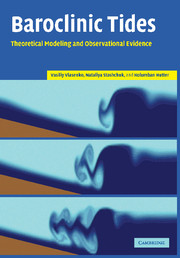Book contents
- Frontmatter
- Contents
- List of tables
- Preface
- Acknowledgements
- List of symbols
- List of abbreviations
- Preamble
- 1 General background
- 2 Linear baroclinic tides over variable bottom topography
- 3 Combined effect of horizontal density gradient and bottom topography on the dynamics of linear baroclinic tides
- 4 Topographic generation of nonlinear baroclinic tides
- 5 Evolutionary stages of baroclinic tides
- 6 Generation mechanism for different background conditions
- 7 Three-dimensional effects of baroclinic tides
- References
- Index
2 - Linear baroclinic tides over variable bottom topography
Published online by Cambridge University Press: 14 August 2009
- Frontmatter
- Contents
- List of tables
- Preface
- Acknowledgements
- List of symbols
- List of abbreviations
- Preamble
- 1 General background
- 2 Linear baroclinic tides over variable bottom topography
- 3 Combined effect of horizontal density gradient and bottom topography on the dynamics of linear baroclinic tides
- 4 Topographic generation of nonlinear baroclinic tides
- 5 Evolutionary stages of baroclinic tides
- 6 Generation mechanism for different background conditions
- 7 Three-dimensional effects of baroclinic tides
- References
- Index
Summary
This chapter is devoted to a study of the dynamics of infinitesimal waves in a continuously stratified ocean of variable depth. Small-amplitude baroclinic tides are usually generated when the intensity of the barotropic tidal forcing is small. As mentioned earlier, depending on the wave amplitude, the analysis can be carried out by means of either the linear or nonlinear theory. A quantitative estimation of the efficiency of the tidal generation of internal waves and the discussion of the necessity to use the full nonlinear system of equations to study baroclinic tides is given in refs. [73] and [75]. We return to this latter point in detail in Chapter 4. Here we simply assume that the amplitudes of the considered waves are so small that with sufficient accuracy the advective terms in the governing system (1.39) can be neglected.
Historically, the first linear models of baroclinic tides were developed for a two-layer ocean. In the models in refs. [199] and [265], the internal tide was generated as a result of the interaction of the barotropic tidal wave with a Heaviside-like bottom step, an obstacle, which approximates the transition zone between the deep and shallow parts of the ocean. In these works, reflection of the waves from the coastal line was used as a boundary condition.
- Type
- Chapter
- Information
- Baroclinic TidesTheoretical Modeling and Observational Evidence, pp. 44 - 103Publisher: Cambridge University PressPrint publication year: 2005



